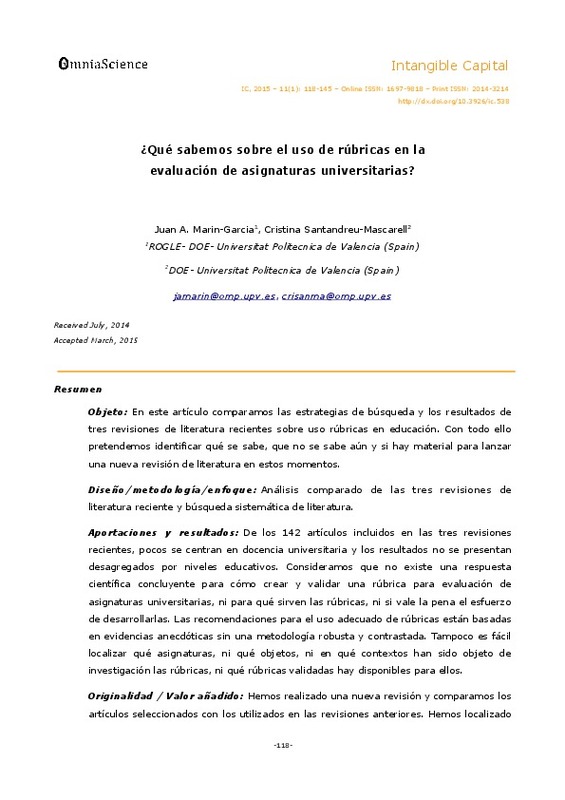|
Resumen:
|
[EN] Purpose: In this paper we compare the search strategies and the results of three recent literature reviews on the rubrics use in education. With all this we aim to identify what is known, what it is not known yet and ...[+]
[EN] Purpose: In this paper we compare the search strategies and the results of three recent literature reviews on the rubrics use in education. With all this we aim to identify what is known, what it is not known yet and if there is material to launch a new literature review right now.
Design/methodology/approach: Comparative analysis of three recen literature reviews and systematic literature review.
Findings and Originality/value: Of the 142 papers included in the three recent reviews, few focus on university learning and the results are not broken down by educational level. We believe that there is no conclusive scientific answer to how to create and validate an assessment rubric for university courses, or what purpose they serve , or if it s worth the effort to develop them. Recommendations for the appropriate use of rubrics are based on anecdotal evidence without robust and proven methodology. Nor is easy to find what subjects, or what objects, and in what contexts have been investigated the rubrics or which validated rubrics are available.
Originality/value: we conducted a new review and we compare the selected papers with those used in previous reviews. We have located 241 new papers not included in previous reviews. Probably all this new material can be used in the future for a meta-analysis
Keywords
rating; scoring; rubric; Higher Education; systematic Literature Review; assessment instrument; educational; learning; self-assessment; peer-assessment
.
[-]
[ES] Objeto: En este artículo comparamos las estrategias de búsqueda y los resultados de tres revisiones de literatura recientes sobre uso rúbricas en educación. Con todo ello pretendemos identificar qué se sabe, que no ...[+]
[ES] Objeto: En este artículo comparamos las estrategias de búsqueda y los resultados de tres revisiones de literatura recientes sobre uso rúbricas en educación. Con todo ello pretendemos identificar qué se sabe, que no se sabe aún y si hay material para lanzar una nueva revisión de literatura en estos momentos. Diseño/metodología/enfoque: Análisis comparado de las tres revisiones de literatura reciente y búsqueda sistemática de literatura.
Aportaciones y resultados: De los 142 artículos incluidos en las tres revisiones recientes, pocos se centran en docencia universitaria y los resultados no se presentan desagregados por niveles educativos. Consideramos que no existe una respuesta científica concluyente para cómo crear y validar una rúbrica para evaluación de asignaturas universitarias, ni para qué sirven las rúbricas, ni si vale la pena el esfuerzo
de desarrollarlas. Las recomendaciones para el uso adecuado de rúbricas están basadas en evidencias anecdóticas sin una metodología robusta y contrastada. Tampoco es fácil localizar qué asignaturas, ni qué objetos, ni en qué contextos han sido objeto de investigación las rúbricas, ni qué rúbricas validadas hay disponibles para ellos.
Originalidad / Valor añadido: Hemos realizado una nueva revisión y comparamos los artículos seleccionados con los utilizados en las revisiones anteriores. Hemos localizado 241 nuevos artículos no incluidos en las revisiones anteriores. Probablemente con todo este nuevo material se pueda realizar en el futuro algún meta-análisis.
[-]
|









